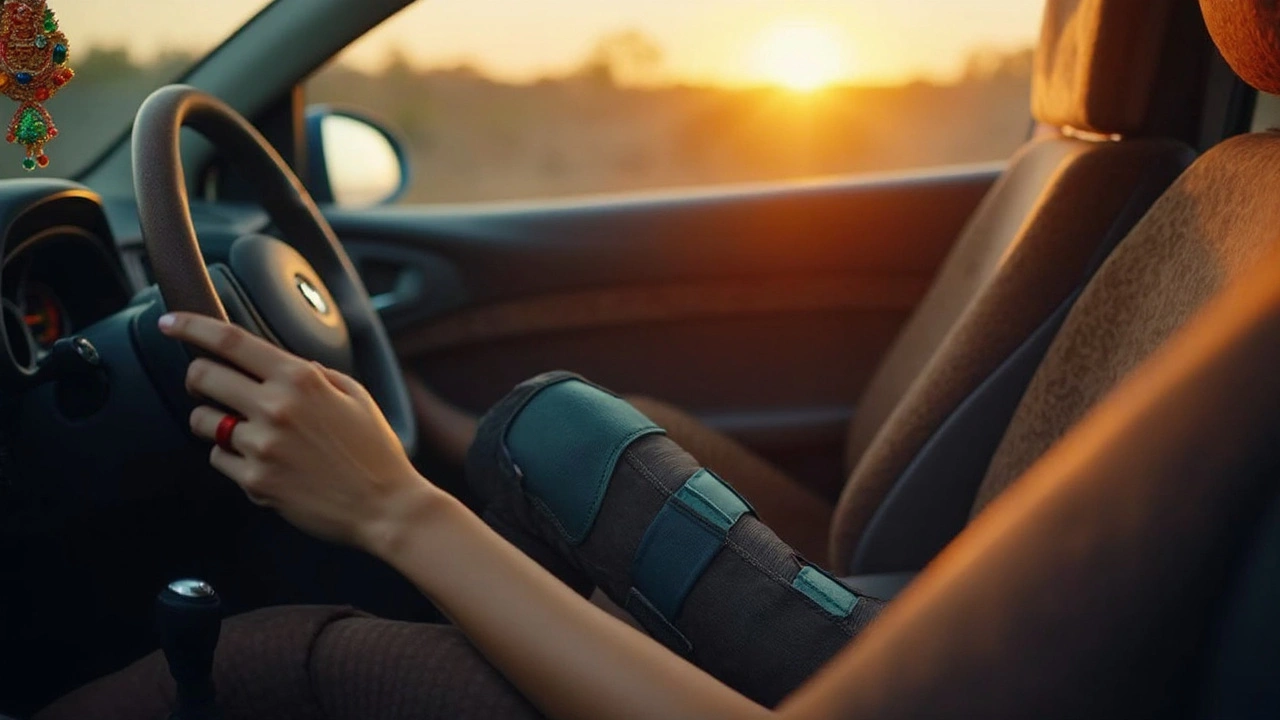So, you've just had knee surgery, and you're wondering when you can get back behind the wheel. It's a common question, especially because being able to drive is a crucial part of regaining your independence. Now, driving two weeks post-surgery might sound a bit optimistic, but let's break it down.
First off, everyone's healing is different. Some people bounce back quickly, while others take more time. Generally, after knee replacement, it can take anywhere from 2 to 8 weeks before you can drive safely again. The key is making sure you're ready, both physically and mentally.
Before you even think about turning the ignition, ask yourself: can you comfortably bend your knee to operate the pedals? Are you still on pain meds that might impair your ability to drive? If the answer to either is no, it might be best to wait a little longer.
But hey, don't just take my word for it. Have a chat with your doctor. They know your specific situation and can give you the best advice on when it's safe for you to get back on the road. Plus, you don't want to mess with any legal or insurance issues that could come up if you drive too soon.
If you're itching to drive, consider practicing in a safe, controlled environment first. That way, you can get a feel for how your knee holds up without any added pressure or distractions. Remember, safety always comes first!
- Understanding Recovery Timeline
- Factors Affecting Ability to Drive
- Consulting Your Healthcare Provider
- Safety and Comfort Tips
- Legal Considerations
Understanding Recovery Timeline
Alright, let's talk about the recovery process after a knee replacement. It's not a one-size-fits-all deal, and there are several factors that come into play. On average, you'll hear that it might take about 6 to 8 weeks before you're back to driving, but some folks might be ready a bit sooner while others take longer.
Now, what's actually happening in those weeks? Here's a rough breakdown to give you an idea:
First Few Days
In the initial days post-surgery, your main focus is healing. You're likely to have swelling and pain, and mobility will be pretty limited. Crutches or a walker might be your best buddies right now. Trust me, it's all about patience and following your doctor's advice.
Week 2 to 4
By the time you're hitting the two-week mark, there's usually some progress in walking a bit more steadily. You might start physical therapy, which focuses on gaining movement and strength in your knee. This is vital for preparing you to get back to normal activities – like driving.
But, wait a sec. Even if you're feeling spry at this point, don't hop in the driver's seat just yet. Factors like which leg was operated on and whether you're driving a manual or automatic vehicle play a big part.
Week 4 to 6
At this stage, most folks start feeling significantly better. Movement can become easier, and pain levels might drop. You might find yourself become eager to get back to driving. Just remember, it's not just about feeling less pain; your reflexes and reaction times need to be spot on too!
Week 6 to 8 and Beyond
Many people get cleared to drive somewhere between the 6 to 8 week mark, provided they've got the green light from their healthcare provider. Your knee should have enough strength and flexibility by now to operate a car safely.
In any case, it’s critical to touch base with your doctor. Remember, only your healthcare provider can give you the official go-ahead based on your recovery progress.
Factors Affecting Ability to Drive
When it comes to getting back to driving after a knee replacement, several factors come into play. These aren't just physical, but sometimes mental as well. So, what should you consider?
1. Physical Recovery
Obviously, after knee surgery, your knee needs time to heal properly. In these initial weeks, swelling and stiffness can make bending your knee or pressing pedals tough. Your ability to perform simple leg movements comfortably is key to driving safely.
2. Pain Medications
Strong painkillers can impair your reflexes and judgment. If you're still on meds prescribed post-surgery, driving might not be the best idea. Your reaction time is crucial on the road, so better safe than sorry!
3. Type of Surgery
Did you have surgery on your left or right knee? Believe it or not, it makes a difference. If it's your right knee, you may need more time since it's your driving leg. Those who've had surgery on their left knee may get the green light sooner, especially if they drive an automatic car.
4. Doctor's Advice
Consult your doctor or physical therapist before you start driving again. They can assess your specific case and give the thumbs up when you're ready. It's always a good move to get their professional opinion.
5. Insurance and Legal Issues
Let's not forget the official side of things! Check with your insurance to see if they have any policies regarding driving after surgery. Some may have restrictions until you receive medical clearance.
| Factor | Importance |
|---|---|
| Physical Recovery | High |
| Pain Medications | Very High |
| Type of Surgery | Medium |
| Doctor's Advice | Critical |
| Insurance & Legal | Significant |
All these factors combined can provide a clearer picture of your readiness. Always prioritize your safety and the safety of others on the road. Assess each factor carefully, and when in doubt, wait it out!

Consulting Your Healthcare Provider
After your knee replacement, one of the best steps you can take is having a heart-to-heart with your doctor. They know the ins and outs of your surgery, recovery progress, and can give you personalized advice about when you should consider getting back on the road.
Why It's Crucial
Your recovery is not just about feeling ready; it's about ensuring your knee can handle the actions you'll be doing while driving. Your doctor can assess whether you're physically capable of rotating your knee comfortably and have enough strength to react quickly in case of an emergency.
Questions to Ask
- How far along am I in my recovery?
- Am I cleared to stop taking pain meds that might affect my driving?
- What exercises can I do to help strengthen my knee for driving?
- When can I schedule a follow-up to evaluate my progress?
The Role of Physical Therapy
Your healthcare provider may also recommend physical therapy. Therapy can significantly improve your mobility and strength post-surgery. It's wise to ask your therapist about specific exercises that can aid with driving.
Studies have shown that patients undergoing physical therapy can often reach key recovery milestones faster, which might just bump up your timeline for driving safely again.
Legal and Insurance Implications
Another less-talked-about point is the legal side. Insurance companies often want to know if you're medically cleared to drive post-surgery. Your healthcare provider can provide the necessary documentation to ensure you're on the right side of any policies.
At the end of the day, talking to your healthcare provider isn't just a suggestion—it's a must. Don't rush the process; after all, your safety and recovery should be your top priorities.
Safety and Comfort Tips
Getting back to driving after knee replacement surgery can be a mix of excitement and nerves. To make this transition smoother, let’s focus on some practical safety and comfort tips. Remember, the main goal is to ensure that you're safe on the road while also feeling at ease during your drive.
Car Adjustments
Make sure your seat is adjusted to the right height and distance. You should be able to comfortably reach the pedals without overextending your knee. Adjust the backrest so that your back and knee are supported.
Consider fitting your car with additional supports like a cushion or knee brace, especially during those first few drives. These can make a big difference in comfort levels.
Test Runs
Before you hit the road for real, try some test runs in a safe and quiet place. Start with short drives, maybe around your neighborhood. This helps you gauge how your knee responds without the stress of traffic.
Timing and Routes
Choose times to drive when the roads are less busy. Rush hours or heavy traffic times are not optimal when you're just getting back into driving. Knowing your route in advance and opting for less congested paths can help in reducing stress and make your drive more comfortable.
Monitor Swelling and Pain
Pay attention to how your knee feels both during and after driving. If you notice swelling or pain, it might be a sign to take it easy and give your knee some more time. In these cases, icing your knee post-drive can help reduce discomfort.
Emergency Ready
- Carry a phone with emergency contacts saved in case you need assistance.
- Keep a first-aid kit within reach, including pain relief if advised by your doctor.
Understanding Pain Medication
If you're still taking pain medication following your knee surgery, know how it affects your alertness. Any meds that might cause drowsiness or impair your driving should leave you thinking twice before heading out. Always consult with your healthcare provider about any risks.

Legal Considerations
Getting back to driving post-knee surgery involves some important legal considerations you shouldn't overlook. First off, you need to think about your insurance. Most insurance policies have clauses that could deny claims if you drive against medical advice. So, always check with your insurer and read the fine print to avoid potential pitfalls.
Also, depending on where you live, there might be legal requirements regarding fitness to drive after medical procedures. Some places mandate informing the local DMV or equivalent about any significant surgery that could impact driving ability, like a knee replacement.
Doctor's Approval
One of the best ways to stay on the safe side legally is to get a written note or certification from your healthcare provider. This document should state that you're cleared to drive. Trust me; it's better to have that piece of paper just in case you need it.
Understanding Impairment
Remember, if you're still on heavy pain medication, it could be considered illegal to drive. Medications can impair your reaction times and judgment, which is a big no-no on the road. Consider this as seriously as possible because it’s about your safety and that of others.
It's also worth considering whether there are legal requirements around adaptive equipment if you're not fully recovering yet. Gear like hand controls might be a necessity if operating pedals is painful or risky.
Being aware of these considerations isn't just about avoiding legal issues. It's about being responsible and ensuring that you're driving safely for yourself and everyone else on the road. So take a little time to sort these things out before you grab those car keys.

 Unveiling the Secrets of Vitamin C for Radiant Skin
Unveiling the Secrets of Vitamin C for Radiant Skin
 Ayurvedic Cleanse Side Effects: What to Watch For
Ayurvedic Cleanse Side Effects: What to Watch For
 Boost Your Metabolism for Weight Loss After 60
Boost Your Metabolism for Weight Loss After 60
 Can You Choose a Baby’s Gender with IVF? Complete Guide
Can You Choose a Baby’s Gender with IVF? Complete Guide
 Essential Tips for Post-Knee Replacement Bowel Movements
Essential Tips for Post-Knee Replacement Bowel Movements